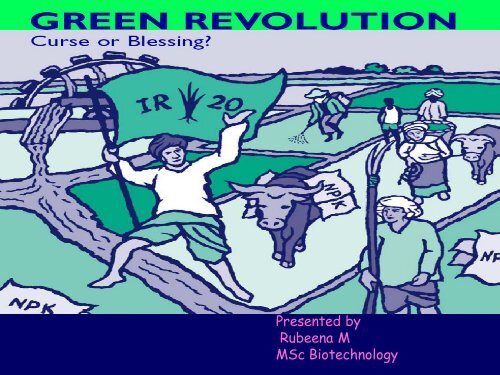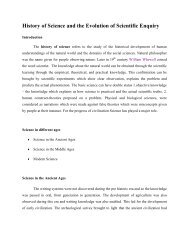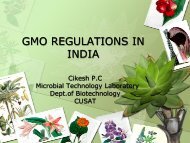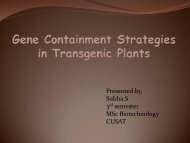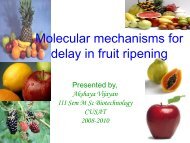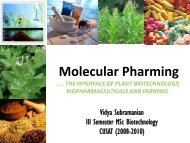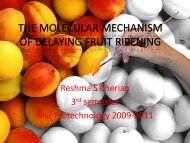Green Revolution - (CUSAT) â Plant Biotechnology laboratory
Green Revolution - (CUSAT) â Plant Biotechnology laboratory
Green Revolution - (CUSAT) â Plant Biotechnology laboratory
You also want an ePaper? Increase the reach of your titles
YUMPU automatically turns print PDFs into web optimized ePapers that Google loves.
Presented byRubeena MMSc <strong>Biotechnology</strong>
Rockefeller Foundation 1943- Mexican Agriculture Project 1956- the program taken to India, Pakistan and China.Fund for International Rice Research Institute ,Philippines. Invest in plant biotechnology research 1999, the then president Gordon Conway warned Monsanto ofthe use of terminator genes 1990s emphasis to Africa2006 it joined with the Bill & Melinda Gates Foundation AGRA(Alliance for a <strong>Green</strong> <strong>Revolution</strong> in Africa)
Father of the "<strong>Green</strong> <strong>Revolution</strong>"• Norman Borlaug, Ph.D., received theNobel Peace Prize in 1970• Picked up Norin strain of wheat andcrossed it with Mexico's best varieties atthe International Maize and WheatResearch Centre .• 1960s India discovered Borlaug and theNorin dwarf. A small field at Pusa wasseeded and the results were dramatic…
Daruma(Japanese semi-dwarf)XFultz(U.S. winter wheat, high yield)Fultz- Daruma(semi-dwarf, high yield)XTurkey Red(U.S. winter, high yield)Locals(adapted toU.S. Northwest)XGaines(semi-dwarf, winter,U.S. adopted)Norin 10(semi-dwarf, winter, high yield)(Dr Gonziro Inazuka in 1935)XNew WheatsLocal Strains(semi-dwarf, high yield, adaptable,rust-resistant, fast-maturing,spring)
Why <strong>Green</strong> <strong>Revolution</strong>• Bengal Famine 1943, four million died of hunger• Cause: an epidemic of brown spot disease Cochliobolusmiyabeanus -acute shortfall in food production ??• Amartya Sen“Result of hysteria related to World War II “• India haunted by memories of the Bengal Famine.• Food security paramount item on free India's agenda.• Led to the <strong>Green</strong> <strong>Revolution</strong> in India and legislativemeasures .
Pesticides Irrigation projectsTechnologies Synthetic nitrogen fertilizer. Novel technological development :production of “High Yielding Varieties.” No lodging Early maturing Fertilizer responsive High grain: straw ratio Disease resistant
Increased nitrogen-absorbing potentialSemi-dwarfing genes bred to avoid lodging.eg. Norin 10 wheat, IR8 HYVs outperform traditional varieties in thepresence of adequate irrigation, pesticides, andfertilizers. HYVs developed as F1 hybrids, need to bepurchased every season increasing cost ofproduction.Produces less non-grain biomass
Impacts on Agricultural ProductionCereal production more than doubled indeveloping nations between the years1961 – 1985<strong>Green</strong> <strong>Revolution</strong> agriculture producesmonocultures of cereal grains, while traditionalagriculture usually incorporates polyculturesTraditional systems of agriculture displacedeg. Chinampas in Mexico
Effects on Food Security“Dealing with two opposing forces, thescientific power of food production and biologicpower of human reproduction.”Avoid widespread famine. Shift of subsistence-oriented cropland tocropland oriented towards production of grainfor export and animal feed.Pesticides eliminated fish and weedy greenvegetables from the diets.
Socioeconomic Impacts• Technological solutions sought as an alternativeto expanding agrarian reform initiatives.• Establishment of rural credit institutions.• Smaller farmers went into debt and loss of rightsto their farmland.• Increased mechanization removed source ofemployment from rural economy.
Socioeconomic impacts cont..• Increased interregional economic disparities.• Increased rural-urban migration, industryunable to absorb all of the displacedagricultural labor.• Wealthier farmers had better access to creditand land -increased class disparities.
Globalization• International Agricultural Research Centersshared information.• Transnational funding groups. eg. RockefellerFoundation, Ford Foundation.• New markets for seed and chemicalcorporations.• eg.Standard Oil of New Jersey established inPhilippines.
PesticidesEcological changes• Increased use of pesticides to limit the high levelsof pest damage in monocultures.• Organochlorides -DDT and Dieldrin accumulatesthrough the food chain.• Toll on soil fertility.• Poisoning of farm workers• Contamination of water table.• Evolution of resistance in pest organismpopulations .Water Issues• Salinization , waterlogging, and lowering of watertables.
Ecological Changes cont..Biodiversity• Reduce Agricultural biodiversity• Susceptibility to pathogens that cannot becontrolled by agrochemicals.• Permanent loss of genetic traits bred into cerealvarieties over thousands of years.• Massive seed banks :International <strong>Plant</strong> GeneticResources Institute established.• Expanded agricultural development into newareas where it was once unprofitable or tooarid.
<strong>Green</strong> <strong>Revolution</strong> in India“From a Begging bowl to a Bread basket.”
• Borlaug’s “MIRACLE SEEDS..”Lerma Rojo and Sonora 64M.S. Swaminathan, G.S. Athwal, S.P. Kohli,V.S. MathurSona , Kalyan, Sonalika
<strong>Green</strong> <strong>Revolution</strong> in India3 basic elements• Continued expansion of farming areas.• Double-cropping.• Two "monsoons" per year. Natural monsoon andArtificial 'monsoon.'• Using seeds with superior genetics.• The Indian Council for Agricultural Research reorganizedin 1965 and then again in 1973.• New high yield value (HYV) seeds, Eg.K68 varietyfor wheat.• Developed by Dr. M.P. Singh regarded as theHero of India's <strong>Green</strong> revolution.
<strong>Green</strong> <strong>Revolution</strong> in India“Father of the <strong>Green</strong> <strong>Revolution</strong>"• M S Swaminathan was an entirelyhome-grown plant genetist ofrepute.• Leadership and success inintroducing and developing highyielding varieties of wheat in India.• Founder and Chairman of the MSSwaminathan ResearchFoundation, leading the“Evergreen <strong>Revolution</strong>”.
C. Subramaniam• In 1965, the Union Minister forAgriculture imported 18,000 tonnes of theseeds of the Lerma Rojo 64A and Sonora64.• Krishi Vigyan Kendras, Model farms andDistrict block development offices• Indian Council for Agricultural Researchreorganized• Chemicals and fertilizer- new industrialunits licensed.• Two crops a year and monsoonindependence-irrigation canals and deepwater wells created.• Assured guaranteed prices and markets.• Food stock storages created.
Benjamin Peary Pal• At the Indian AgriculturalResearch Institute [IARI],developed the New Pusa 809, ahardy Indian wheat variety.• The father of post-modernresearch in India's agriculture.• Other varieties Pusa Sonara,Malavika, Kalyan Sona.
Results of the <strong>Green</strong> <strong>Revolution</strong>• Record output of 131 million tons in 1978-79.• India became an exporter of food grains.• High-yield varieties needed more fertilizer,pesticides, fungicides - growth of the localmanufacturing sector created new jobs andcontributed to country's GDP.• Increase in irrigation created new dams toharness monsoon water.• Used to create hydro-electric power.
Results of the <strong>Green</strong> <strong>Revolution</strong>• The <strong>Green</strong> <strong>Revolution</strong> was one factormade Mrs. Indira Gandhi (1917-84) andthe Indian National Congress, a verypowerful political force in India• India paid back all loans taken from theWorld Bank and its affiliates for thepurpose of the <strong>Green</strong> <strong>Revolution</strong>.
Limitations of the <strong>Green</strong> <strong>Revolution</strong>• The <strong>Green</strong> <strong>Revolution</strong>, NOT succeeded in makingIndia totally and permanently self-sufficient in food• India failed to extend the concept of high-yield valueseeds to all crops or all regions Only Punjab andHaryana states and eastern plains of the River Gangesin West Bengal state showed the best results.
Limitations of the <strong>Green</strong><strong>Revolution</strong>• Confined to food grains only.• Even today, there are places like Kalahandi(in India's eastern state of Orissa) -starvationdeaths have reported, due to reasons otherthan availability of food in India.• <strong>Green</strong> <strong>Revolution</strong> not a 100% success.
Evergreen <strong>Revolution</strong> ??Increasing Productivity without associated ecologicalharm…Organic agriculture : without use ofmineral fertilizers and chemical pesticides<strong>Green</strong> Agriculture : with the help ofintegrated pest management, integratednutrient supply and integrated naturalresource management systems
• Eco agriculture : Conservation of soil, waterand biodiversity , the application of traditionalknowledge and ecological prudence.• EM Agriculture : farming using effectivemicroorganisms (EM)• White agriculture : Based on substantial useof fungi• One-straw <strong>Revolution</strong> : farming withoutploughing, chemical fertilizers, weeding andchemical pesticides and herbicides
Second <strong>Green</strong> <strong>Revolution</strong>??• Average growth rate 1.5 % in the last three years asagainst the target of at least 4 %.• To achieve 7-8 % annual economic growth, acceleratethe rate of growth in agriculture.• P.M Man Mohan Singh- Indian industry stepping upinvestment in agriculture and through public-privatepartnership.• Institutional framework providing long-term capital forinvestment in agriculture is weak.• Public investment in irrigation and wastelanddevelopment, funds for agricultural research andcreating a single market agricultural produce.
• Centers on privately owned technologies —GM plants.• 6 multinationals :BASF <strong>Plant</strong> Science, Bayer CropScience, Dow, Dupont, Monsanto and Syngenta —control research ,their products and research methodsshackled in patents.• Private goods accessed at significant cost: a bag of 'Bt'GM cotton seeds by Monsanto-Mahyco costs US$41 inIndia, compared to US$6.60-8.80 for superior localvarieties.• 'Terminator' seeds-sterile adult plants, reduce farmers tohelpless consumers — not partners, as they were duringthe <strong>Green</strong> <strong>Revolution</strong>.
Indo-US Alliance…A Boon or Bane??• U.S.-India nuclear deal, little attention to thedeal on Agriculture.• Under the terms of the deal, the U.S. and India willlink their agriculture institutes and conduct jointresearch in biotechnology to develop drought andheat- resistant crops.
Gene bank break-in?Indo-US deal focus on accessing biological resources inIndian gene banks, and India's intellectual propertyrights regime.To develop the GM crops (and fish and livestock) ,theUS bioscience corporations want access to the richbiodiversity in Indian gene banks, research stations andUniversity collections. .
Gene bank break-in?Restrictions on imports of US farm productsinto India to be removed. i.e. right toexport GM crops and foods to India.“Avoid becoming thedumping ground forcontroversial products.”
2006-07 : Year of Agricultural RenewalMutually interactive and reinforcing action plans.Soil Health Enhancement.Irrigation Water Supply AugmentationCredit and InsuranceTechnology - bridging the know-how to do how gap.Farmer-friendly Market
Credit and InsuranceReducing rate of interest for crop loans to 4 %.Agricultural Risk Fund to provide farmers reliefduring disease and disaster.Need for Rural Insurance Development Fundand Credit.Promote and make Crop Insurance farmerfriendly.
<strong>Green</strong> …<strong>Revolution</strong>…Gene <strong>Revolution</strong> ….Controversy over GeneticallyModified Organisms (GMOs)We’re all related—what does“Foreign DNA” really mean?Mother nature is also abiotechnologist !
Facing the Challenge of Sea level RiseAvicennia marinacDNA libraries were constructed fromthe Mangrove species AvicenniamarinaTransgenic plants with salinity tolerance genes
Genetic YieldPotentialGMOs for 21st CenturyInsect andDiseaseResistanceHerbicideResistanceNutritionalQualityAbioticStresses
Africa is theGreatest WorryHigh population growth, evenwith AIDS200 million hungry andmalnourished peopleDeclining soil fertility and littleapplication improved technologyRural isolation—lack of roads and transportPoor education and health services
“You CannotBuild Peace onEmptyStomachs.”John Boyd OrrNobel Peace LaureateFirst FAO Director General
Thank U…


